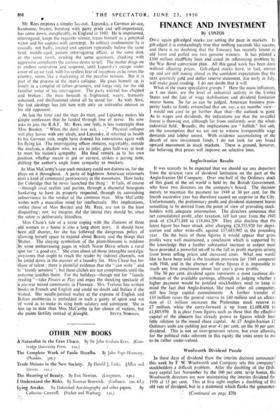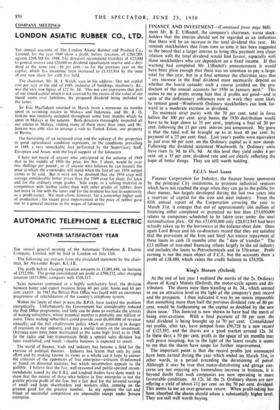FINANCE AND INVESTMENT
By CUSTOS ONCE again gilt-edged stocks are setting the pace in markets. In gilt-edged it is outstandingly true that nothing succeeds like success, and there is no doubting that the Treasury has recently found its old form and pulled out two genuine winners. It has piloted a £100 million electffcity loan and eased its refinancing problem by the War Bond conversion plan. All this good work has been done without affecting prices. Gilt-edged stocks have, in fact, moved up and are still nosing ahead in the confident expectation that the next quarterly gold and dollar reserve statement, due-early in -July, will make good reading. I do not doubt that it will. What of the more speculative groups ? Here the main influences, as I see them, are the level of industrial activity in the United States and the fate of wage stabilisation and dividend limitation nearer home. So far as can be judged, American business pros- perity looks so firmly entrenched that on, say, a six months' view— I would not care'to go further than that—the outlook is good. As to wages and dividends, the indications are that the so-called freeze is thawing out, although far from uniformly over the whole industrial field. Broadly, the implications are " bullish," but only on the assumption that we are not to witness irresponsible wage demands and labour unrest. With evidence accumulating of the dearth of new investment funds, I do not look for any broad upward movement in stock markets. There is ground, however, for believing that prices will improve on selective lines.
Anglo-Iranian Results
It was scarcely to be expected that we should, see any departure from the strictest view of dividend limitation on the part of the Anglo-Iranian Oil Company. Over one-half of the Ordinary stock of this giant of the oil world is held by the British 'Government, who have two directors on the company's board. The decision merely to maintain the payment for 1949 at 30 per cent. for the fourth successive year has therefore caused no surprise in the City. Unfortunately, the preliminary profit and dividend statement leaves something to be desired from the point of view of providing stock- holders with adequate information. The directors announce that net consolidated profit, after taxation, fell last year from the 1948 peak of £24,471,888 to £18,444,209. They also disclose that the latest figure has been struck after charging £24,353,920 for depre- ciation and other write-offs, against £17,683,902 in the preceding year. On the basis of those figures it would appear that gross profits were well maintained, a conclusion which is supported by the knowledge that a further substantial increase in output must have provided a powerful set-off to the fall in profit margins arising from lower selling prices and increased costs. What one would like to have been told is the taxation provision for 1949 compared with 1948, and in the absence of these figures it is impossible to reach any firm conclusion about last year's gross profits.
The 30 per cent: dividend again represents a most cautious dis- tribution of the available earnings, although in judging whether a higher payment would be justified stockholders need to keep in mind the fact that Anglo-Iranian, like most other oil companies, still has large capital commitments. A further transfer of £10 million raises the general reserve to £40 million and an alloca- tion of £1 million increases the Preference stock reserve to £7 million, while the carry-forward is up from £1,608,438 to £1,885,970. It is clear from figures such as these that the effective capital of the concern has already grown to figures which bear little relation to the issued share capital. At £7 Anglo-Iranian LI Ordinary units are yielding just over 4.1 per cent. on the 30 per cent. dividend. This is not an over-generous return, but even allowing for the political risks inherent in this equity the units seem to me to be rather under-valued.
Woolworth Dividend Puzzle
In these days of dividend thaw the interim decision announced this week by F' W. Woolworth and Company sets this company's stockholders a difficult problem. After the doubling of the Ordi- nary capital last November by the 100 per cent. scrip bonus, the Woolworth directors are now maintaining the interim dividend for 1950 at 15 per cent. This at first sight implies a doubling of the old rate of divi4nd, but in 'a statement which flanks the wmounce-
-.,
(Continued on page 870) FINANCE AND INVESTMENT—(Continued from page 868)
ment Mr. B. E. Uffindell, the company's chairman, warns stock- holders that the interim should not be regarded as an indication
that there will be an increase in the total dividend this year. He reminds stockholders that from time to time it has been suggested to the board that a larger interim to bring this payment into closer
relation with the total dividend would find favour, especially with those stockholders who are dependent on a fixed income. If that warning had completed Mr. Uffindell's announcement it would have been plain enough that there was no intention to pay a larger total for this year, but in a final sentence the chairman says that " any increase in the final dividend must necessarily depend on whether the board consider such a course justified on the pro- duction of the annual accounts for 1950 in January next." This seems to me a pretty strong hint that if profits are good—and in spite of the deflationary influences now at work they seem likely to remain good—Woolworth Ordinary stockholders can look for- ward to a moderate increase in dividend.
To maintain strict parity with the 70 per cent. total in force before the 100 per cent. scrip bonus the 1950 distribution would have to be kept down to 35 per cent., implying a final of 20 per cent. following the 15 per cent interim just announced. My guess is that the total will be brought up to at least 40 per cent. by payment of a 25 per cent. final. Last year's profits were equivalent to just over 60 per cent. on the Ordinary capital as it now stands. Following the dividend statement Woolworth 5s. .Ordinary units have risen Is. 9d. to 47s. 9d. At this level they yield under 4 per cent. on a 35 per cent. dividend rate and are clearly reflecting the hope of better things. They are still worth holding.
F.C.I.'s Steel Loans Finance Corporation for Industry, the finance house sponsored by the principal City institutions to promote industrial ventures which have not reached the stage when they can go to the public for their money, has largely developed during the last two years into a reservoir of capital for the iron and steel industry. From the fifth annual report of the Corporation covering the year to March 31st, it emerges that out of approximately £66 million of financing either completed or promised no less than £53,050,000 relates to companies scheduled to be taken over under the steel nationalisation plan. _ Of this £53,050,000 only £20,812,945 had been actually taken up by the borrowers at the balance-sheet date. Once again Lord Bruce and his co-directors record that they are satisfied that the provisions of the Iron and Steel Act ensure repayment of these loans in cash 18 months after the " date of transfer." The £13 million of non-steel financing relates largely to the oil industry and includes the loans to Petrochemicals and to Ultramar. Profit earning is not the main object of F.C.I., but the accounts show a profit of £38,480, which raises the credit balance to £74,926.
King's Motors (Oxford)
At the end of last year I outlined the merits of the 2s. Ordinary shares of King's Motors (Oxford), the motor-cycle agents and dis- tributors. The shares were then standing at 8s. 3d., which seemed to me an attractive level in the light pf the company's past record and the prospects. I then indicated it was by no means impossible that something more than half the previous dividend rate of 80 per cent. would be forthcoming on the capital as doubled by the new share issue. This forecast is now shown to have had the merit of being over-cautious. With a final payment of 50 per cent. the total dividend is being brought up to 70 per cent. Consolidated net profits, after tax, have jumped from £90,728 to a new record of £123,392, and the shares are a good market around 12s. 3d. In these days a 50 per cent. profit in the space of six months may well prove tempting, but in the light of the latest results it seems to me that the shares have scope for further improvement.
The important point is that the record profits just announced have been earned during the year which ended on March 31st, in other words, in a period preceding the derationing of petrol. Although it may be true that motor-distributing and garage con- cerns are not enjoying any tremendous increase in business, it is beyond doubt that such companies are now operating in more favourable conditions. At 12s. 3d. the 2s. Ordinary shares are now offering a yield of about 113 per cent. on the 70 per cent. dividend. This seems to me an over-generous return. When profit-taking has been absorbed the shares should attain a substantially higher level. They are still well worth buying.



































 Previous page
Previous page